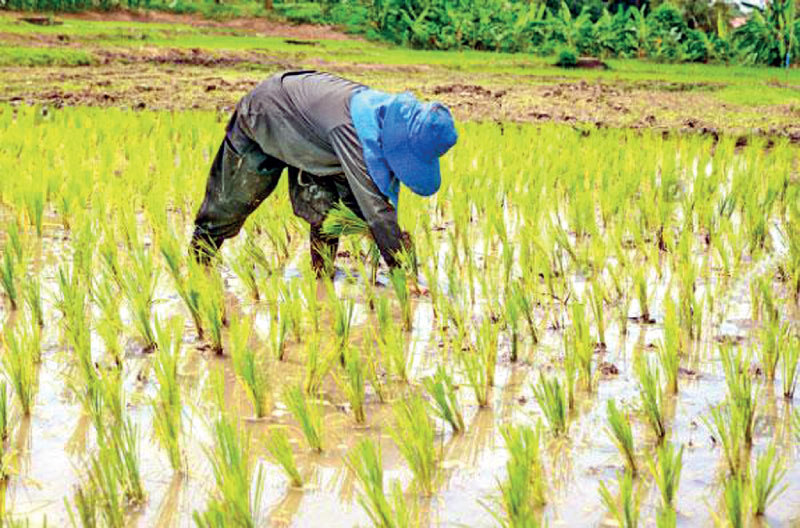Saturday Dec 06, 2025
Saturday Dec 06, 2025
Monday, 27 January 2025 00:01 - - {{hitsCtrl.values.hits}}

The best way is to allow the market forces to work, and intervene when there is domination of single or few players in determining prices of paddy and rice or any other malpractices

Professor Buddhi Marambe
|
Sri Lanka’s rice industry has been at crossroads facing numerous challenges every year with production, marketing, pricing, and availability issues that have impacted not only the farmers but citizens across the nation. At these critical times the Daily FT sought the views of Professor Buddhi Marambe, a former Dean of the Faculty of Agriculture, University of Peradeniya, now attached to the Agriculture Faculty as a Senior Professor.
His candid views not only diagnose the root causes but also offer pragmatic solutions aimed at re-vitalising the sector and offering a roadmap to overcome these obstacles and thereby ensuring the sustainability of one of Sri Lanka’s most vital agricultural commodities
 Q: Every year there is talk of rice shortage, how true is this?
Q: Every year there is talk of rice shortage, how true is this?
The demand for rice in Sri Lanka changes due to various reasons and traditional festivals play an important role, where the demand for rice increases in the months of April/May and December/January. When supply cannot meet the excess demand in those specified months, we experience a shortage. In some years, climate change and ad hoc policy changes have made a significant impact on paddy production. In 2016 and 2017, three consecutive cultivating seasons failed due to droughts prompting the Government to import 748,000 Mt of rice to feed our population. In 2022 we imported 783,000 Mt of rice, as a result of the disastrous policy decision taken in 2021 to ban imports of fertilisers and pesticides, which mainly contributed to the loss of total paddy yield by 34% in the following year.
Q: Where actually is the real problem? Is it in the paddy or is it the rice? Or both
A: The Department of Census and Statistics estimates the overall paddy yield through crop cut surveys using an approved sampling framework. In 2024, after discounting for seed paddy stored for the next cultivating season (approx. 130,000 Mt) and wastage of 380,000 Mt, the total paddy yield available for consumption was approx. 4,240,000 Mt, of which 2,420,000 Mt was from the Maha season (2023/2024) and 1,820,000 Mt from the Yala season (2024). Though there is a ban on using paddy/rice for animal feed and alcohol production (which are not taken into account by the Department of Agriculture), recently it was revealed in parliament that about 350,000 Mt of paddy is used annually for animal feed, and 30,000 Mt annually for alcohol production. Once these values are accounted for, the total availability of paddy for consumption would reduce to 3,860,000 Mt in the year 2024.
With this data the Department of Agriculture estimates the rice availability considering the milling outturn as 68% (e.g. 68 kg of rice by milling 100 kg of paddy), As for now, the main concern is this % milling out turn, where the Government Institute of Post-Harvest Technology and Management states as 65%, while main millers claim it to be 62.5%, and small and medium scale millers claims this to varies from 52% to 62%. The discrepancy has resulted in a massive variation in the estimated amount of rice, making it extremely difficult for a Government to take data-driven decisions.
Considering a per capita rice consumption of 112.4 kg per year, the Department of Agriculture estimates the rice requirement for the country as approx. 2,460,000 Mt. If, the estimated available paddy amount(deducting the amount used for animal feed and alcohol production) was converted to rice with 68% milling outturn, the estimated available rice for 2024 would be 2,624,000 Mt and it would be 2,412,000 Mt based on the 62.5% identified by main millers. Ignoring the other lower milling outturn rates claimed by small and medium scale millers who supply more than 65% of the country’s rice requirement to the market, it is clear that there is an issue on market availability of rice in 2024.
I think this should be the prime focus now in finding solutions to the problems of availability, access and affordability of the main staple. These should be followed by having accurate district level data bases for cultivated extents of different rice varieties/types, etc., to better understand the availability of rice in the market based on consumer preference.
Q: What steps need to be taken to avoid/overcome such situations?
Among many options, the Ministry of Agriculture should first revisit the conversion rates adopted to come up with a more reasonable value for rice availability based on an island-wide survey covering a range of mills. Further, the sampling sites for crop cut survey of paddy may need to be re-visited to have more reliable data so that the Government will be in a position to take better-informed decisions.
Q: Can you briefly explain the current practices/sequences from paddy to rice?
Once paddy is harvested, the collectors (who mostly store paddy), transport service providers, and millers (large, medium and small) play a vital role in having the output of rice to the market through wholesalers and retailers. Farmers dry paddy to reach a moisture content less than 14% mainly by sun-drying and machine-drying, so that the paddy can be marketed at higher price, or be sold as fresh harvest (at about 19-22% moisture) to the collectors or millers at relatively low prices. Paddy stored by the farmers and collectors are sold to millers periodically at relatively high prices depending on the market needs, resulting in a price increase in rice. Paddy that reach millers will be either parboiled before milling, or milled raw.
Q: Does the Government need to take control of the entire process?
Sri Lanka currently adopts more liberal economic policies. In such situations, market forces should work and determine food prices based on competitive performances with a win-win situation to producers, consumers and other players in the value chain. In a general situation, the Government should not do business but regulate and be the watchdog. However, given the economic scenario of the country, the Government interventions are required at least to support the most vulnerable by providing material at a cheaper price through State machinery (e.g. Sathosa). The Government needs to have a real-time database continuously updated with more reliable data to decide on market interventions, especially imports, in a timely and scattered manner rather than flooding the market within a short timespan.
Q: Does the Government need to get involved more in the purchase/storage of paddy?
A developing country like Sri Lanka, which is highly vulnerable to climate change and variable market forces, needs to have buffer stocks of the main staple (rice) to intervene when essentially required. As such, the Paddy Marketing Board (PMB) was established in the country, which currently has 216 warehouses and others acquired from the Food Commissioner’s Department, etc. with a total capacity of about 350,000 Mt. However, the majority of these facilities are of poor quality and need urgent rehabilitation to be done to store paddy.
Such storage will help market interventions by the Government to stabilise market prices of rice to a certain extent by selling the stocks to small and medium scale millers as and when required. In this Maha season (2024/2025) the Government has continued the Pledge Loan scheme with the support of state and private sector banks to provide loans up to Rs. 50 million to small and medium scale millers to purchase and mill lady harvest. The loan is at 7% interest and as for now, repayable in 180 days.
Q: Do you see the need for a purchase/guaranteed price for paddy and a maximum price for rice?
No. The best way is to allow the market forces to work, and intervene when there is domination of single or few players in determining prices of paddy and rice or any other malpractices. However, to make this process fully operational with transparency, an efficient market mechanism should be in place. The worst case scenario is that any Government adopts a guaranteed price for paddy and minimum retail price for rice with the intention of disciplining some market players like the main millers (e.g. to cripple ‘rice mafia’), which is a proven failure. It is the big picture that we should look at in solving such issues as the National level Food Security.
It is important to note that cost of cultivation of paddy will vary from Ampara (Lowest) to Kandy (Highest), depending on the productivity levels, rain-fed or irrigated systems, and type of rice (e.g. Nadu type varieties or keeri samba; red or white grain, parboiled or raw rice), making it difficult to have an overall price structure across the country. It is important to note that once the purchase price of the paddy is fixed or determined by the Government at the national level, the price of rice will be 1.97 to 2.04 times higher than the paddy price to all market players in the food system will receive reasonable profits for smooth operation of the food flow. Once the aspirations of paddy farmers are met through Government intervention, the low-income earners will be at the receiving end.
Q: There is always talk of a rice mafia and large scale millers controlling the market. Is this true? Should the Government intervene and if so how?
I do not believe in this. There were many instances that Government officers raided the main millers, who were said to be storing paddy and controlling the release of rice to the market, and termed as rice mafia. However, the country is kept in the dark regarding the outcome and it seems that there is no such hoarding of paddy or rice by the large scale millers. However, the country is still clueless of the whereabouts of the paddy that was harvested. The farmers usually keep a stock of the harvest for their own direct consumption, marketing the same periodically to ensure other purchases for living, and store a part as seed paddy for future.
Still there should be some players in the system such as collectors of wealthy farmers themselves that would store larger volumes and release them periodically. If such occurs, the ‘Farmer” tag, would help them escape any interrogation for hoarding paddy. As for the collectors, if not farmers, the Government should intervene to register them to have a proper record through monitoring mechanisms, can be maintained about their storage volumes.
Q: Is the fertiliser subsidy for paddy required?
One thing for sure, we have to take farmers out of “Subsidy Mentality”. Subsidies have become election promises and many political parties have banked on such promises, which has spoiled the farming community. Nevertheless, the economic crisis in Sri Lanka has made the price of fertiliser to reach exorbitant levels beyond the reach of many farmers. I support subsidies for the main staple in such situations, but they should be well-directed to the most needed, but not across economic borders. A proper record keeping and accurate data base is a necessity for the Government to embark on such deviations from the current practice.
(The writer is an Agriculture Graduate from the University of Peradeniya, and worked as the Director HR for a leading agri business company in Sri Lanka.)